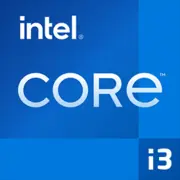Intel Core i3-1315U

인텔 코어 i3-1315U: 모바일 작업을 위한 에너지와 성능의 균형
2025년 3월
소개
현대 노트북은 성능과 배터리 수명 간의 절충을 요구합니다. 2023년에 출시된 인텔 코어 i3-1315U 프로세서는 2년이 지난 현재에도 여전히 예산형 세그먼트에서 유효합니다. 이 칩이 어떤 사용자에게 적합하며, 작업 수행능력은 어떤지, 그리고 장치 선택 시 주의해야 할 점에 대해 살펴보겠습니다.
아키텍처와 기술 공정
랩터 레이크: 하이브리드 접근법
코어 i3-1315U는 랩터 레이크 아키텍처(인텔 7 공정, 10nm Enhanced SuperFin)로 제작되었습니다. 두 가지 유형의 코어가 혼합된 시스템입니다:
- 2개의 성능 코어(P-코어) — Hyper-Threading을 지원하는 고성능 코어(4 스레드), 기본 클럭 1.2GHz, 터보 부스트 최대 4.3GHz.
- 4개의 효율 코어(E-코어) — Hyper-Threading을 지원하지 않는 에너지 효율 코어(4 스레드), 클럭 0.9–3.3GHz.
캐시 및 그래픽
- L3 캐시 10MB는 멀티스레드 작업을 가속화합니다.
- 통합 그래픽 인텔 UHD 그래픽스(13세대)는 64 EU(실행 유닛) 및 최대 1.1GHz의 클럭으로, 4K@60Hz와 AV1 디코딩, HDMI 2.1을 지원합니다.
아키텍처의 특징
- 인텔 쓰레드 디렉터 기술은 P-코어와 E-코어 간의 작업 분배를 최적화합니다.
- DDR5/LPDDR5 및 PCIe 4.0(최대 8 레인)을 지원합니다.
전력 소비 및 TDP
TDP 15W: 성능과 배터리 수명 간의 균형
- 15W의 열 설계 전력(TDP)은 이 프로세서를 슬림한 울트라북 및 수동 냉각 장치에 설치할 수 있게 해줍니다.
- 터보 모드에서 소비는 잠시 55W에 이를 수 있지만, 중간 수준의 쿨링 시스템은 이러한 급증을 처리할 수 있습니다.
전력 절약 기술
- 인텔 다이나믹 튜닝 3.0 — 부하에 따라 전압과 클럭을 자동으로 조절합니다.
- Adaptix — 성능과 배터리 수명 간의 균형을 미세 조정하기 위한 도구입니다.
실제 작업에서의 성능
사무 작업
- Microsoft Office와 같은 응용 프로그램, 10개 이상의 탭이 열려 있는 웹 브라우저, Zoom 회의 등에서 프로세서는 지연 없이 작동합니다. 예를 들어, 3D 요소가 포함된 PowerPoint 프레젠테이션의 렌더링은 2-3초가 걸립니다.
멀티미디어
- HandBrake에서 30분 길이의 1080p 비디오 변환: 약 22분(대비 Ryzen 5 7530U의 18분).
- Netflix 또는 YouTube에서 4K 비디오 스트리밍 — iGPU의 부하는 60%를 초과하지 않으며, AV1 하드웨어 디코딩 덕분입니다.
게임
- 가벼운 게임: CS2 — 낮은 설정(720p)에서 40-50 FPS, Genshin Impact — 25-30 FPS.
- 터보 모드는 GPU의 안정적 주파수를 15분 동안 유지하지만, 콤팩트한 케이스에서 과열로 인해 스로틀링이 발생합니다.
터보 부스트 모드
- Cinebench R23 벤치마크에서: 5617점(멀티스레드)으로 i3-1215U의 4800점에 비해 높습니다. 그러나 부하 시 온도가 95°C에 도달하는 것은 울트라북에서는 일반적입니다.
사용 시나리오
타겟 오디언스:
- 학생 및 사무직 근무자 — 문서 작업, 웹 서핑, 온라인 학습.
- 휴대성을 중요시하는 사용자 — 1.3kg 이하의 노트북(예: Acer Swift 3 2025).
- 서브 장치 — 여행이나 카페에서 작업할 때.
적합하지 않은 사용:
- 게임 사용자(클라우드 게임 제외).
- 비디오 편집자 및 3D 디자이너.
배터리 수명
배터리 작업 시간
- 50-60Wh 배터리를 장착한 장치(예: Lenovo IdeaPad 5) — 혼합 부하에서 최대 10시간(밝기 150 니트, Wi-Fi 사용).
- 활성 사용 시(Chrome + YouTube) — 6-7시간.
전력 소비 최적화
- Windows 12의 '전원 절약 모드'는 E 코어의 클럭을 0.7GHz로 낮춰 배터리 수명을 15-20% 연장합니다.
- 인텔 스마트 캐시는 RAM 접근을 줄여 에너지를 3-5% 절약합니다.
경쟁 제품과 비교
AMD Ryzen 5 7530U (Zen 3, 6코어/12스레드)
- 장점: 멀티스레드 작업에서 더 높은 성능(Cinebench R23: 6200점), Radeon Graphics는 20% 더 빠릅니다.
- 단점: 배터리 수명이 1-2시간 더 짧고, 노트북 가격이 $700부터 시작합니다.
Apple M2 (8코어, 10코어 GPU)
- M2 MacBook Air는 더 비싸며($999), 15시간 이상의 배터리 수명과 비디오 편집에서 즉각적인 반응성을 제공합니다. 그러나 Windows 소프트웨어와의 호환성은 제한적입니다.
인텔 코어 i5-1335U
- $100-150 더 비쌉니다: 10코어(2P+8E)로 렌더링 성능이 더 높습니다. 하지만 사무 작업에서는 추가 비용이 항상 정당화되지는 않습니다.
코어 i3-1315U의 장단점
강점:
- 노트북 가격이 $500부터 시작합니다.
- Wi-Fi 6E 및 Thunderbolt 4 지원.
- 부하 상황에서도 조용하고 차갑습니다.
약점:
- 총 8 스레드(12 스레드인 Ryzen 5에 비해 적음).
- 720p 이상의 게임에 적합하지 않은 그래픽.
- 미래에 대한 제한된 여유(최소 3-4년).
노트북 선택 추천
2025년 최적 모델:
- 예산형 울트라북: HP Pavilion Aero 13(가격: $550-600) — 무게 1.1kg, 2.5K IPS 디스플레이.
- 범용 노트북: ASUS Vivobook S15 — 15.6인치 FHD, 16GB RAM, 512GB SSD($650).
유의 사항:
1. RAM: 최소 16GB LPDDR5(2025년 기준 8GB는 부족함).
2. 디스플레이: 풀 HD 이상의 해상도, IPS 패널.
3. 포트: 미래의 주변기기를 위한 Thunderbolt 4.
4. 냉각: 안정적인 터보 부스트를 위한 듀얼 팬 시스템.
결론
인텔 코어 i3-1315U는 일상적인 작업을 위한 저렴한 노트북을 찾는 사용자에게 적합한 선택입니다. 그의 주요 장점은:
- 사무 및 멀티미디어에 충분한 성능.
- 컴팩트한 디자인에서 8-10시간의 배터리 수명.
- 최신 통신 표준(Wi-Fi 6E, Thunderbolt 4) 지원.
자원 집약적인 시나리오에서 더 강력한 CPU보다 뒤처지지만, $500-700의 가격대에서 학습, 작업, 오락을 위한 이상적인 균형을 제공합니다. 예산이 제한되어 있고 요구 사항이 적당하다면 이 프로세서를 고려해 보아야 합니다.
기초적인
CPU 사양
메모리 사양
GPU 사양
여러 가지 잡다한
벤치마크
다른 CPU와 비교
소셜 미디어에서 공유하기
또는 링크로 소개하기
<a href="https://cputronic.com/ko/cpu/intel-core-i3-1315u" target="_blank">Intel Core i3-1315U</a>


